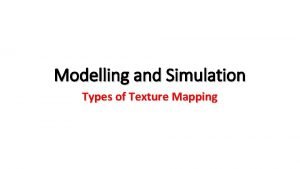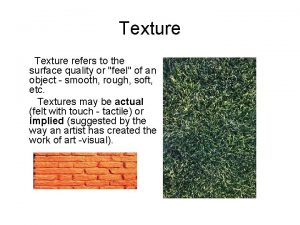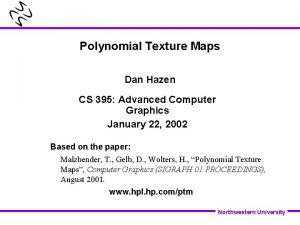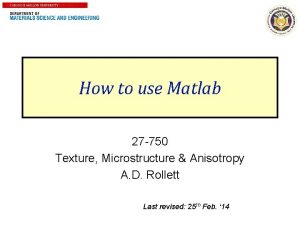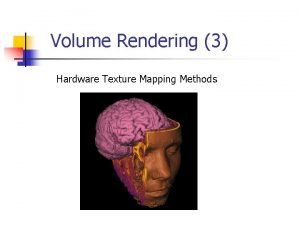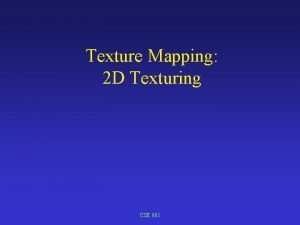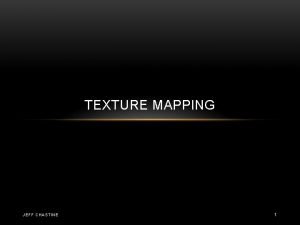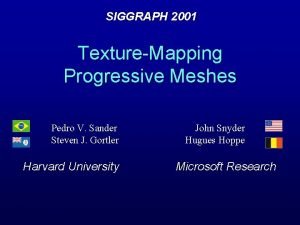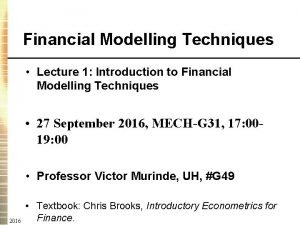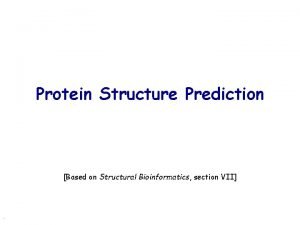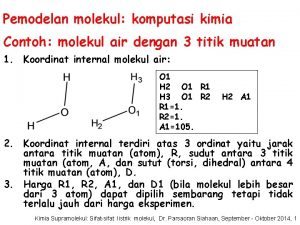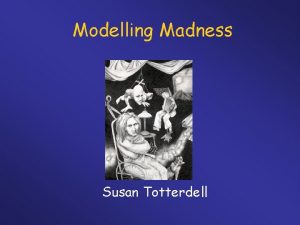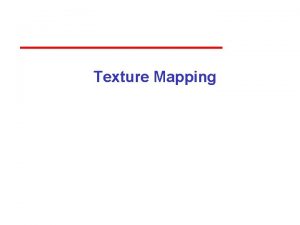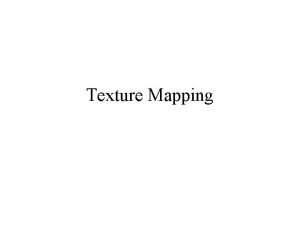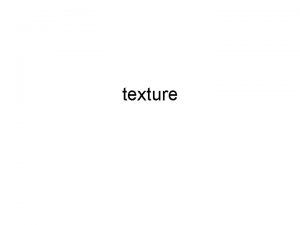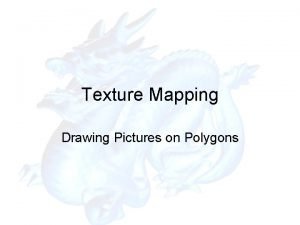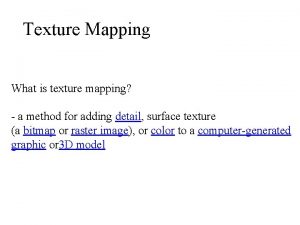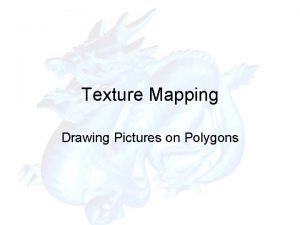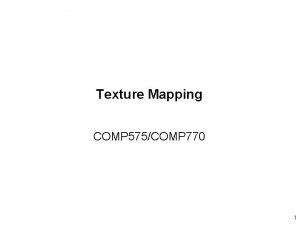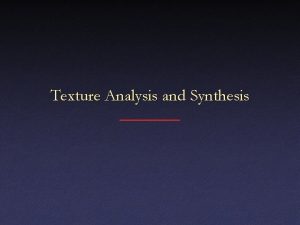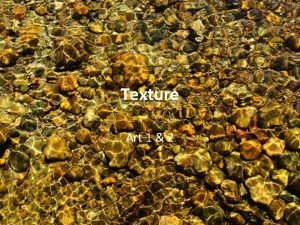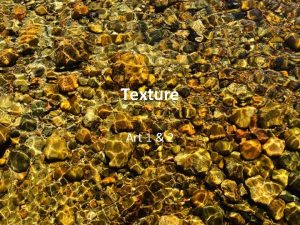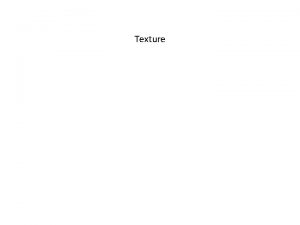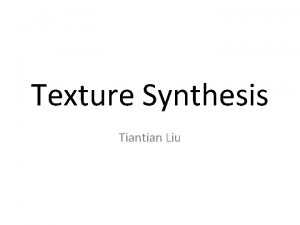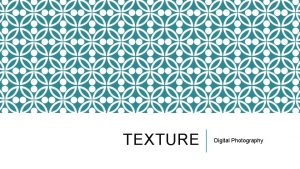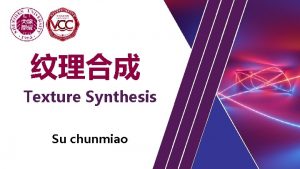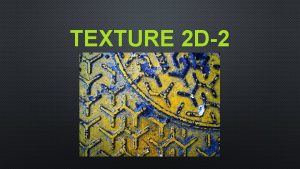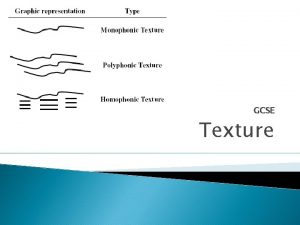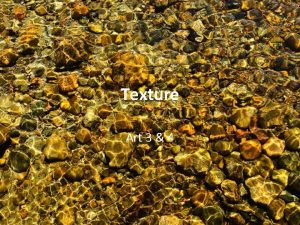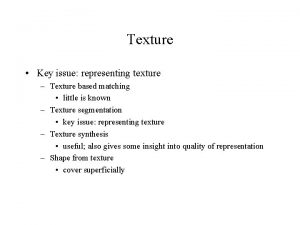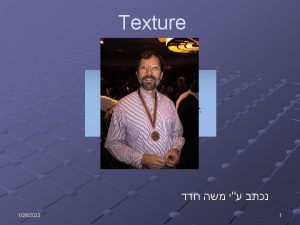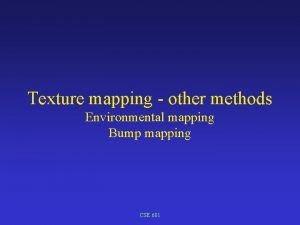Modelling and Simulation Types of Texture Mapping Types























- Slides: 23

Modelling and Simulation Types of Texture Mapping

Types of Texture Mapping • Textures can be used to control many different attributes of a surface, to produce different effects in your rendering. The seven most common mapping techniques are: • • Color, diffuse Specular Transparency Displacement Bump Normal Incandescence

Types of Texture Mapping • Color and Diffuse Mapping • Color mapping (sometimes called diffuse mapping) replaces the main surface color of your model with a texture. A black-and-white grid is applied as a color map in Figure. A sphere with a basic color map

Types of Texture Mapping • Color and Diffuse Mapping • Your color map sets the tint and intensity of diffuse light reflectance by a surface. In some renderers, color mapping and diffuse mapping are listed as two different kinds of maps. In this case, the tones of the color map are multiplied by the tones of the diffuse map. For example, a 50 percent gray in a diffuse map would cut the brightness of the color map in half. A sphere with a basic color map

Types of Texture Mapping • Color and Diffuse Mapping • Color mapping replaces the object color used in diffuse illumination, but does not override your lighting and shading. It is best to avoid having highlights, shadows, or lighting variations appear in the color maps themselves when you render, lighting will be added by the lights. A highlight mapped onto your model as a part of a color map could look fake, as if it were just painted onto the object's surface. As a result, the best color maps usually look very flat when viewed by themselves, such as the color map for a man's face shown in Figure. Color maps should not show any built-in lighting.

Types of Texture Mapping • Color and Diffuse Mapping • In a realistic rendering, object colors usually should not include pure black or pure white, and should avoid completely saturated red, green, or blue colors. A 100 percent white color would mean that 100 percent of the light hitting the surface was diffusely reflected, which does not occur in the real world. Similarly, a pure black surface would show no diffuse light reflectance, which is also unrealistic. In most cases, it's a good idea to keep the red, green, and blue color values in your texture maps between 15 and 85 percent. While your texture maps may look a bit flat by themselves, your final render will gain contrast and directionality from your lighting, as shown in Figure. A head model textured with the color map from previous Figure

Types of Texture Mapping • Specular mapping varies the brightness and color of the specular highlights on different parts of an object's surface. A checkered pattern is applied as a specular map around the entire object in Figure, but its influence is seen only in the area of the specular highlight. A sphere with a grid as a specular map

Types of Texture Mapping • Specular Mapping • Your specular map will not create specular highlights by itself; highlights still need to come from light sources. Your specular map can tint the highlights, change their brightness, or even block them completely from a particular part of your model. However, the effects of specular mapping will be visible only in places where a specular highlight would have appeared anyway.

Types of Texture Mapping • Specular Mapping • Bright areas in your specular map make highlights brighter, creating a glossier or shinier area on your object. Dark tones of a specular map make highlights less visible, and pure black in a specular map completely prevents highlights from showing up on the corresponding parts of your model. For example, Figure shows a specular map for a man's face. White areas of the map produce a shiny forehead and nose, while dark areas prevent highlights on the stubble of his chin and cheeks.

Types of Texture Mapping • Transparency mapping has several useful functions. The simplest function of a transparency map is to create a pattern in a surface's transparency. Instead of making a surface uniformly transparent, you can make parts of it less transparent, such as if a window were dirty, or give it different colors of transparency, such as to create a stained glass window.

Types of Texture Mapping • Transparency Mapping • Figure shows a white and black checkerboard applied to a surface's transparency. Dark areas of a transparency map will make a surface less transparent, and light areas make the surface clearer. A sphere is transparency mapped with a checkerboard pattern

Types of Texture Mapping • Transparency Mapping • Transparency mapping can also be used to cut out detailed shapes and patterns from a surface. Figure shows a transparency map designed to simulate hairs or eyelashes. Most 3 D programs can use a texture map's alpha channel to determine the level of transparency in a textured surface. The eyelash texture map contains color information, which can be applied as a color map, and also contains transparency information in its alpha channel. An eyelash texture uses an alpha channel for transparency.

Types of Texture Mapping • Transparency Mapping • A transparent area of a surface will not necessarily be invisible. Reflections, refraction, and specular highlights are still visible on a transparent surface. If you want to be sure transparent parts of your surface are completely invisible, you can reuse the transparency map to map the specularity and reflectivity, to make them both become 0 wherever the transparency is 1. Ear hair and eyelashes are created with transparency mapping.

Types of Texture Mapping • Displacement Mapping • The brightness of a displacement map is used to change the shape of a surface. The brighter the tone in a displacement map, the farther out a point on the surface will be displaced. Figure shows the checker pattern displacement mapped onto a sphere. The change to the shape of the sphere is most noticeable at the edges.

Types of Texture Mapping • Displacement height determines how far in or out a displacement map should push your surface. In many shaders, you also have an offset parameter to set how much displacement you start with where the map is pure black. You might leave the offset at 0 so that black in the displacement map has no effect, or you might make it start at a value of -0. 5 so that black displaces the surface inward and a middle gray is used where you want the map to have no effect.

Types of Texture Mapping • Bump mapping is a trick that simulates small details on an object's surface, without actually displacing the geometry. Figure shows the influence of a checkerboard as a bump map. Bump mapping isn't as convincing as displacement mapping, but can render much more quickly. A bump map simulates ridges without changing the shape of the sphere.

Types of Texture Mapping • Bump mapping works by changing the surface's shading as if small details had been present. The shading of a surface is based on an angle called the surface normal, which is usually perpendicular to the geometric surface of an object. A bump map changes the surface normals, making the object respond to light as if additional details had been present in the geometry. • Bump maps are encoded with brighter tones representing higher elevations, and darker tones representing lower elevations. A white dot would represent a bump up from the surface, and a dark dot would represent a depression into the surface. A transition from dark to light would create a ridge between different altitudes. People often use a neutral 50 percent gray as a starting point for a bump map, but any flat tone will work the same way. In a bump map, an area of constant color, with no variation in shading, will have no effect on a surface.

Types of Texture Mapping • Bump Mapping The water is a smooth surface (left), but adding a bump map distorts reflections and highlights (right) in this scene by Gladys Leung (www. runtoglad. com).

Types of Texture Mapping • Normal mapping is similar to bump mapping in that it cheats your shading without actually changing the shape of the model. • Compared to bump mapping, normal mapping is a more direct, specific way to perturb surface normals. In bump mapping, pixel brightness is interpreted as a height, and a slope derived from the heights of adjacent pixels determines the angle assigned to surface normals. In a normal map, a 3 D angle for a normal is directly specified by three values per pixel, stored as three color channels in the map.

Types of Texture Mapping • Normal Mapping A high polygon model (left) can be replaced by a low polygon model (center) if it is made to look higher resolution with a normal map (right).

Types of Texture Mapping • Incandescence mapping (also called luminosity, ambience, or constant mapping) uses a texture map to simulate self-illuminating properties of an object. The colors in an incandescence map are added to the colors in your final rendering, without regard for your lighting. As shown in Figure, incandescence maps are visible on a surface even in shadow areas; they don't need a light source to illuminate them.

Types of Texture Mapping • Incandescence Mapping • In Alias software, mapping the ambient color is different from mapping the incandescence in that the ambient color gets multiplied by the main shader color before it is added to your illumination. Figure shows an example of this. If you brighten the lampshade with a map on the ambient color (left), the ambient color gets multiplied by the color map, and the texture is preserved and reinforced. Brightening the lampshade with an incandescence map (right) makes the surface brighter but is not filtered through the color map.

Types of Texture Mapping • Incandescence Mapping An ambience map (left) is multiplied by the color map, while an incandescence map (right) is added without regard for surface color.
 Different types of texture maps
Different types of texture maps Surface quality or feel of an object
Surface quality or feel of an object Northwestern university
Northwestern university Matlab texture mapping
Matlab texture mapping Texture mapping algorithm
Texture mapping algorithm 2d texture mapping
2d texture mapping Summed-area tables for texture mapping
Summed-area tables for texture mapping Texture mapping
Texture mapping Texture mapping progressive meshes
Texture mapping progressive meshes The associative mapping is costlier than direct mapping.
The associative mapping is costlier than direct mapping. Forward mapping vs backward mapping
Forward mapping vs backward mapping Transform mapping dan transaction mapping
Transform mapping dan transaction mapping Financial modelling techniques
Financial modelling techniques Advantages and disadvantages of wireframe modelling
Advantages and disadvantages of wireframe modelling Modelling relationships and trends in data
Modelling relationships and trends in data Problem solving and modelling task example
Problem solving and modelling task example Texture of cookies
Texture of cookies Technological modelling
Technological modelling Energy based model
Energy based model Modeling tools in java
Modeling tools in java Molecular modelling laboratory
Molecular modelling laboratory Modelling madness
Modelling madness Models of interaction in hci
Models of interaction in hci Revolver formula min max
Revolver formula min max
